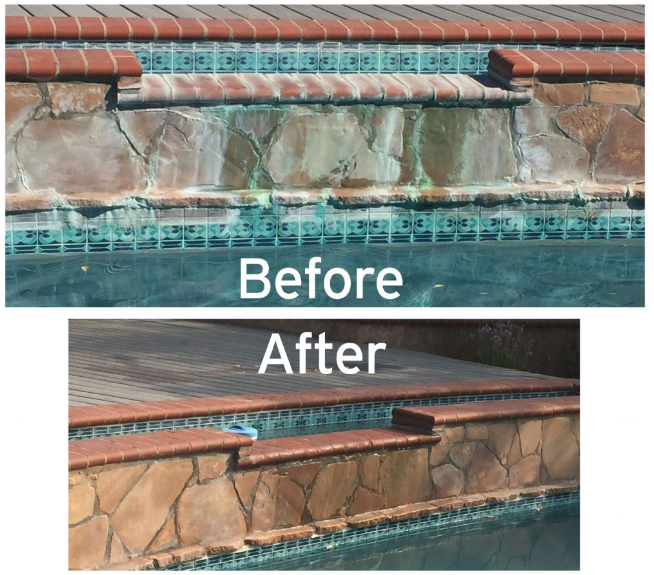Introduction
Calcium buildup on pool tiles is a common issue that can make your pool look unappealing and even cause long-term damage. If left untreated, calcium deposits can harden, making them difficult to remove. In this guide, we will explore the causes of calcium buildup, the best DIY and professional methods to remove it, and tips to prevent future buildup.
What Causes Calcium Buildup on Pool Tiles?
Calcium deposits, also known as scale, form when calcium in hard water settles on pool surfaces. The primary causes include:
- Hard Water: High mineral content in water leads to calcium deposits.
- High pH Levels: Imbalanced water chemistry accelerates calcium scaling.
- Evaporation: As pool water evaporates, minerals are left behind.
- Improper Chemical Balance: Poor pool maintenance can cause calcium to accumulate quickly.
How to Identify Calcium Deposits
There are two main types of calcium buildup:
- Calcium Carbonate: White, flaky, and easy to remove.
- Calcium Silicate: Hard, stubborn deposits that require aggressive cleaning methods.
DIY Methods to Remove Calcium from Pool Tiles
1. Vinegar and Baking Soda Solution
For light calcium deposits, a natural cleaning solution works best. Steps:
- Mix equal parts white vinegar and baking soda.
- Apply the paste to the affected tiles using a soft brush.
- Let it sit for 10-15 minutes, then scrub gently.
- Rinse thoroughly with clean water.
2. Pumice Stone Scrubbing
A pumice stone is effective for calcium carbonate buildup. Steps:
- Wet the pumice stone and pool tile.
- Gently scrub the affected area in circular motions.
- Continue scrubbing until the buildup is removed.
- Rinse with pool water to clear debris.
3. Muriatic Acid Solution (For Stubborn Stains)
Use caution when handling muriatic acid, as it is highly corrosive. Steps:
- Wear gloves and goggles for protection.
- Mix one part muriatic acid with ten parts water.
- Apply the solution using a spray bottle.
- Let it sit for 5 minutes, then scrub with a brush.
- Rinse thoroughly with water.
4. Commercial Calcium Removers
There are specialized calcium removers designed for pool tiles. Steps:
- Choose a high-quality calcium remover.
- Apply the product following the manufacturer’s instructions.
- Scrub gently with a soft brush.
- Rinse well to prevent chemical residue.

Professional Methods for Calcium Removal
If DIY methods are not effective, professional cleaning may be necessary.
1. Bead Blasting
- Uses glass beads, salt, or soft abrasives to remove buildup.
- Highly effective without damaging tiles.
- Performed by professionals for best results.
2. Pressure Washing
- Uses high-pressure water to remove deposits.
- Suitable for tough calcium silicate stains.
3. Acid Washing
- A strong acid solution is used to dissolve calcium deposits.
- Best for extreme cases but should be done by a professional.
Preventing Calcium Buildup on Pool Tiles
1. Maintain Proper Water Chemistry
- Keep pH levels between 7.2 and 7.6.
- Maintain calcium hardness levels between 200-400 ppm.
2. Use a Pool Cover
- Reduces evaporation and mineral buildup.
3. Regular Pool Cleaning
- Brush and vacuum pool surfaces weekly.
- Use a tile scrubber to prevent scaling.
4. Install a Water Softener
- Helps reduce mineral content in hard water.
FAQs
1. What is the best cleaner for calcium on pool tiles?
Muriatic acid, vinegar, and commercial calcium removers are highly effective.
2. Can I use CLR to remove calcium from pool tiles?
Yes, but always check product labels to ensure pool-safe usage.
3. How often should I clean my pool tiles?
At least once a month to prevent buildup.
4. Is calcium buildup harmful to my pool?
Yes, excessive scaling can damage tiles and affect water circulation.
5. Can I prevent calcium buildup completely?
While it’s hard to eliminate, maintaining water balance and regular cleaning can minimize it.
6. Does vinegar dissolve calcium deposits?
Yes, vinegar is an effective natural solution for light calcium deposits.
Conclusion
Calcium buildup on pool tiles is a common issue, but with the right cleaning methods and maintenance, you can keep your pool looking pristine. Whether you choose DIY techniques like vinegar and baking soda or professional methods like bead blasting, regular upkeep is key to preventing future buildup. By following these tips, you can enjoy a clean and sparkling pool all year long!

